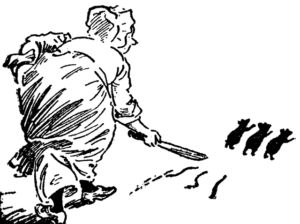The beloved season of Thanksgiving is on the horizon. Ordinarily I try to pen an essay with some artistic, pedagogic, or seasonal value. But occasionally a topic gets under my skin, and I can’t make it go away. So it goes with this week’s post. Next week’s will be more seasonal, I promise.
They all went after the farmer’s wife,
Who cut off their tails with a carving knife. . . .
 Not any more, it seems. Apparently, in today’s P.C. world, toddlers aren’t supposed to hear about cutting off “tails with a carving knife.” (At least so it appears, based on a doctored rendition found on an otherwise delightful CD borrowed from the library.)
Not any more, it seems. Apparently, in today’s P.C. world, toddlers aren’t supposed to hear about cutting off “tails with a carving knife.” (At least so it appears, based on a doctored rendition found on an otherwise delightful CD borrowed from the library.)
Recorded children’s music is still a new field for me. We didn’t have all this stuff when I grew up—just Golden Books and a couple of kids’ 78s. Instead, we learned reams of song by hearing adults sing them and through our daily school music classes.
Our own kids (adopted at ages 6 and nearly 14) came to us chocked full of traditional songs, poems, and outdoor games learned during their years in rural Russia. So, we were able immediately to launch them into the broader musical culture: opera, symphony, Broadway musicals and American classic songs. Consequently, plowing through today’s recordings of little-kid music has been unnerving.
Unnerving? Yes, because so much of it is so bad! My best example is a CD bought en route to a conference when we first began traveling with our two-year old granddaughter. I presumed (wrongly) that a major-label recording would have high-quality children’s songs. Maybe some do, but certainly not this one!
Our ears recoiled in protest before the first sixteen bars were over. We didn’t know what was worse: the mind-numbing back-beat, the sanitized arrangement, or the annoying, electrified “voices” of the children’s choir.
Hank and I then scrolled through and could not find a single track we could tolerate or put before her untutored ear in good conscience. The whole thing nearly drove us into a ditch.
At the next gas station, I wanted to throw it out. Hank said: “Keep it. Maybe you can use it in a lecture as an illustration of bad music.” And I have.
So, back to Three Blind Mice. I was actually enjoying this library CD, finding most of it well done in terms of style. But then we got to “the culprit.” We all know the words:
Three blind mice,
Three blind mice.
See how they run,
See how they run.They all ran after the farmer’s wife,
Who cut off their tails with a carving knife.
Did you ever see such a sight in your life as
Three blind mice?
Everything about the text and music is in perfect balance. Unless, of course, someone decides to erase an entire line from the song.
They all ran after the farmer’s wife,
Did you ever see such a sight in your life as
Three Blind Mice?
Yep. I had to listen to it twice to make sure I wasn’t losing my mind. The whole “carving-knife” line was skipped over.
Well, we can’t have someone whack off the mice’s tails, can we?
There are so many problems here, but let’s take an analytical perspective. Three Blind Mice, like so many nursery songs, has a classical structure. It opens with two sets of two lines (two couplets) that are matched by a set of four lines (quatrain). The last line of the quatrain repeats the poem’s first line, nicely emphasizing the classical “roundness” of the verse.
| Three blind mice, | (1st couplet, 1st musical phrase) |
| Three blind mice | |
| sp | |
| See how they run, | (2nd couplet, 2nd musical phrase) |
| See how they run. | |
| sp | |
| They all ran after the farmer’s wife, | (quatrain, 3rd musical phrase) |
| Who cut off their tails with a carving knife. | |
| Did you ever see such a sight in your life, as | |
| Three blind mice? |
Furthermore, in terms of pitch structure, all four lines of the first two couplets are built on descending, conjunct pitches (mi, re, do). The next three lines in the quatrain open with an ascending interval (They all; Who cut; Did you e-).
The linking word as brings us back to a repeat of the opening melodic shape—three descending pitches on the last iteration of three blind mice.
That’s a structure Mozart would have approved! For that matter, he did turn occasionally to nursery and folk tunes for his material, not that he ever needed much outside help with melody.
Here’s what really matters about such nursery songs: a child who hears and sings them repeatedly will assimilate important lessons in Western melodic structure, harmonic patterns, and poetic design. So, let’s not mess with perfection. Unless you object to perfection, which someone clearly did on this CD.
 But that tail business. Can we have something so untoward enter our children’s ears?
But that tail business. Can we have something so untoward enter our children’s ears?
I might be sympathetic if the same parties raising the alarm (someone must be) weren’t handing their kids iPads. Or, if the NRC (Nursery-Rhyme Censors) instructed us to shy away from today’s hyper-marketed “kid movies” saturated with vile monsters, bathroom humor, and mindless violence.
So, let this be known: in our household, the poetic and musical forms of our cultural heritage will stay intact. The real offense lies not in whacking off a tail, but in the insidious deed of whacking a song to shreds, destroying its symmetry and balance due to a shallow fear it might offend.




Wow! Thank you for the musical explanation. I have enjoyed nursery rhymes and children’s songs and I had never thought about why they sounded good. But I especially like the ones that are “round,” even though I didn’t know what “round” was. :)
Very well said.Interesting enough children don’t seem to experience it as real as we are. When I was a child the farie tale with the cut of head from a horse,that talked when the princess (who was called the maid) came underneath the gate didn’t bother me. Probably bec children still live in a fsntasy world where everything is possible,even a talking horse head.I did not feel it’s brutality like I would now as an adult. Still I might change the “words” of a song,but not cut out whole sections,if I don’t want my children singing that negative line over and over. We changed the complete words of frozen just for fun made it a powerful Christian song. I also agree with your opinion about dumping down children songs. Just trying to find some german folksongs on you tube and listening to that midi sound of the instrumentation is not a pleasure to our ears. Thanks.